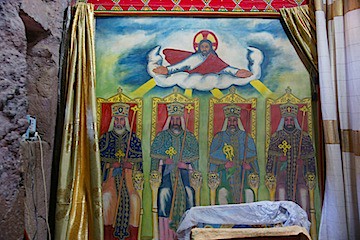
I had little pre-conception about the 8th wonder of the World, the rock hewn churches of Lalibela. They were 12th century, so I imagined little hovels of stone. They were carved from the rock, so I imagined a facade like Petra in Jordan. What I found could not have been more impressive, breath taking and unlike a medieval Petra if it tried.
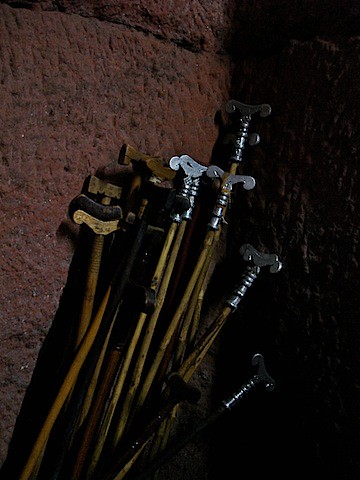
Lalibela is suffused with religion in the most lively way. Our guide was a chanter and our receptionist was up at 6, wrapped in his white shama on his way to pray. Young boys from the countryside dream of growing up to become priests, who are part of village life with their wives and families (unlike Catholics, Ethiopian orthodox priests are allowed to marry). Orthodox religion is fused into people's lives for better or worse (the church is the only entity in Ethiopia apart from the state that owns land, so there is little incentive to raise the peasants above their current level of ignorance and poverty), there are churches in every small village, priests are sitting by the side of the road soliciting donations and dispensing blessings, flanked by a picture of Mary, a donation box and a shiny umbrella.

I had thought of Ethiopia as a remote and unreachable place, like Albania or Tibet, never to be seen by me, so reaching Lalibela was unexpected, despite being on our route from the beginning. We arrived there after two long days of driving on gravel roads through the mountains north of Addis Ababa, breathtaking views and old Italian-built roads and tunnels making us think we were in the Alps. We were tired when we got there and debated whether it had been worth it, but our visit to the churches the next day wiped that question from our minds.

The churches are by the nature of their architecture not really part of the village, but sited separately in three locations in the hills. They are quite invisible from the road, apart from the protective roofs that have been built over them to protect the rock from weather. The churches are really underground, carved down into the softly pink volcanic tuff that once flowed over the region and hardened like raspberry meringue. To create the churches first a trench was excavated around a square block of rock, which was then pierced to create the interior of the church. This makes the buildings flush with the rocky ground. Access to the churches is via the trenches surrounding them, which are kept scrupulously clean by troops of cleaners, who remove dust and lichen that may damage the buildings. The churches are still in a poor state, a mystery to me as they have been in constant use for the last 800 years, owned by a living church that doesn't look short of money in other ways (something like 700 priests, monks and apprentices are directly employed by the church in Lalibela), There are cracks in the facades from a 17th century earth quake, badly executed maintenance from previous regimes and general decay inside and out.
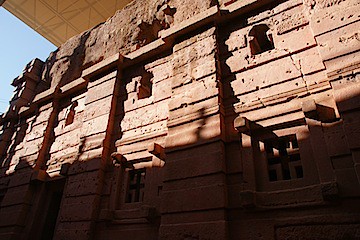
Regardless, the space is quite unlike anywhere I have been before. After descending into the trench we faced an awesome building, Bete Medhane Alem, the biggest rock hewn church in the world. It's incomprehensible to me how an architect, a sculptor, a builder could think themselves into the negative space to be created, where instead of erecting a new construct a solid shape had to be hollowed out, detracted from, with all the implication that once something is removed it can't be added back in. The amazing thing to me is that the churches look like real buildings (they even have fake wooden window supports, copying a local contemporary building style, even though, being stone, they are not needed), with windows and doors, pillars, steps, internal arches and decorations, drainage and storage spaces, seats and ledges.
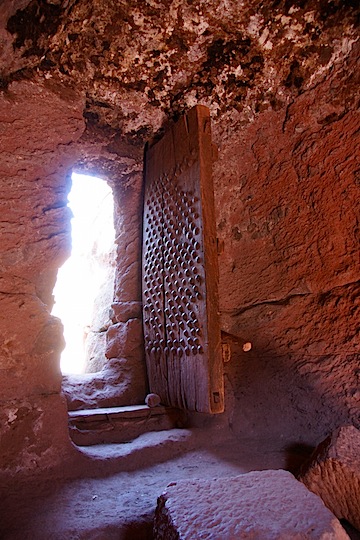
Walking around the first complex of churches (there are three), with its 6 churches all tangled up with walkways and staircases, trenches connecting each to the next, holes in the walls that used to give homes to hermits and mummies, dead ends and hidden entrances, one is completely cut off from the day above, it's cold and dark where the town is hot and dusty, its quiet where the town is full of children on their way to school and touts drumming up business. Stepping inside a church is even gloomier, and there is a strange absence: paintings draped and drums abandoned on the carpet where the chanters left them after morning service; empty benches where worshippers crowd in the mornings; curtains drawn on the altar and holy shrine, not to be revealed until the next mass; carpets rolled up awaiting a holy day so that they can be unrolled to spruce the place up. The lone priest sits in vigilance waiting to display the churches cross to visitors, and reads his prayer book.
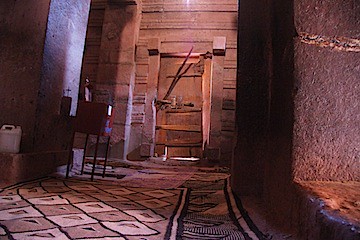
Some of the churches are decorated inside, apart from the paintings propped everywhere, mostly new prints of saints, although some are painted on cloth and look to be no older than a few hundred years. They don't seem to be valuable, maybe they get replaced when they wear out, the image more important than the craftsmanship. Bete Maryam has carved and painted patterns covering the pillars and a series of cartoon like frescoes depicting miracles and the annunciation. They are easy to decipher, in a naive style with simple symbolism so even I could keep up.
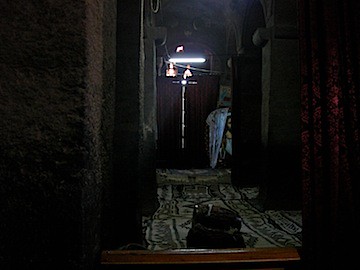
The interiors are quite dark, making for moody shots of light streaming in though door ways and touching the edges of pillars, illuminating rather than lighting. What light falls through the small windows and doors is already diminished by the fact that we are underground, with a canvas roof over our heads. A few cold strip lights are haphazardly rigged under the ceiling, wires strung across frescoes and in and out of window frames. This gives a utilitarian feel to the mysterious gloom, harsh electric light cutting through the dark with white smears. The light creates rooms different from the physical space, highlighting a folded up carpet or the corner of a painting, giving importance to disjointed parts of unrelated objects.

In amongst all the theatrical decorations, the drapes and images, sits the priest, sometimes busily chanting from his prayer book, sometimes dozing until the guide suggests that he display the church's treasure. Then he poses in a lit space in front of the picture of his saint, all solemn seriousness clad in white, draped with a colourful shawl. Posing over, he plonks the cross down on a stool, covers it with a cloth and returns to his meditations.
EDIT:
And here finally, two countries on, are the rest of Stuart’s fantastic photos:

No comments:
Post a Comment